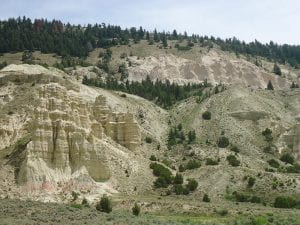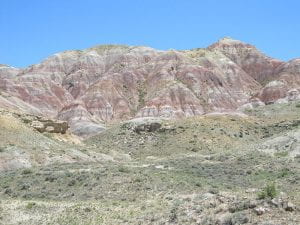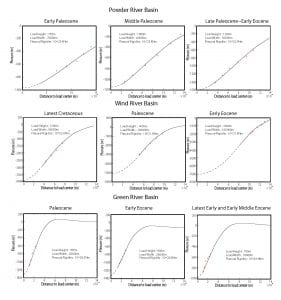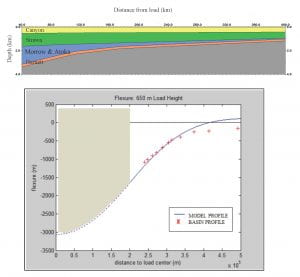MIDDLE-LATE CENOZOIC UPLIFT AND CLIMATE CHANGE ALONG THE STRIKE OF THE ROCKIES
 Despite several decades of study, the process of the formation of the Rocky Mountains (Rockies), the world’s longest intracontiental mountain belt, and its adjacent high Great Plains remains enigmatic. The high topography of the Rockies has altered atmospheric circulation and therefore written a paleoclimatic signature on western U.S. climates. This project 1) investigates the uplift history and associated climate changes along the strike of the Rocky Mountains in western U.S. during the middle and late Cenozoic; 2) calibrates clumped isotope geothermometry of carbonate cement to promote its broad applications in tectonic and paleoclimate questions; 3) constrains the chronostratigraphic framework of the middle and upper Cenozoic strata in the western and southern U.S.A. We combine oxygen and clumped isotope ratios of continental carbonate, and hydrogen isotope ratios of hydrated volcanic glass to document surface uplift and climate changes; and use detrital zircon geochronology to document sediments provenance and improve age constraint.
Despite several decades of study, the process of the formation of the Rocky Mountains (Rockies), the world’s longest intracontiental mountain belt, and its adjacent high Great Plains remains enigmatic. The high topography of the Rockies has altered atmospheric circulation and therefore written a paleoclimatic signature on western U.S. climates. This project 1) investigates the uplift history and associated climate changes along the strike of the Rocky Mountains in western U.S. during the middle and late Cenozoic; 2) calibrates clumped isotope geothermometry of carbonate cement to promote its broad applications in tectonic and paleoclimate questions; 3) constrains the chronostratigraphic framework of the middle and upper Cenozoic strata in the western and southern U.S.A. We combine oxygen and clumped isotope ratios of continental carbonate, and hydrogen isotope ratios of hydrated volcanic glass to document surface uplift and climate changes; and use detrital zircon geochronology to document sediments provenance and improve age constraint.
Publications: Fan et al., 2014a,b; Hough et al., 2014; Fan et al., 2015; Rowley and Fan, in review.
Student thesis: Rowley, 2013; Mankin, 2014; Ayyash, 2015; Godfrey, ongoing; Brown, ongoing; Zhu, ongoing
LATE CRETACEOUS-EARLY EOCENE SEDIMENTARY RECORD OF THE LARAMIDE DEFORMATION AND PALEOCLIMATE
 Although the Laramide Rockies have served as the archetype example of thick-skinned intracontinental deformation in order to explain other basement-cored uplifts around the world and deep into geologic time, the flat-slab subduction model has been substantially refined and diversified in the recent years. This project aims at 1) understanding the surface processes and testing geodynamic models for the formation of the central Rockies and constrains the role of flat subduction in deforming continental interior during the latest Cretaceous-early Eocene; 2) constraining the regional climate and environment in Wyoming during the early Eocene. We combine surface uplift constrained by paleoelevation proxies and erosion history constrained by sedimentology and isotope geochemistry to reconstruct the amount of rock uplift, and document the spatial and temporal patterns in the central Rockies. We use stable isotope geochemistry and rock magnetic properties to reconstruct paleoclimate and paleoenvironment, and spectral analysis to identify orbital cycles.
Although the Laramide Rockies have served as the archetype example of thick-skinned intracontinental deformation in order to explain other basement-cored uplifts around the world and deep into geologic time, the flat-slab subduction model has been substantially refined and diversified in the recent years. This project aims at 1) understanding the surface processes and testing geodynamic models for the formation of the central Rockies and constrains the role of flat subduction in deforming continental interior during the latest Cretaceous-early Eocene; 2) constraining the regional climate and environment in Wyoming during the early Eocene. We combine surface uplift constrained by paleoelevation proxies and erosion history constrained by sedimentology and isotope geochemistry to reconstruct the amount of rock uplift, and document the spatial and temporal patterns in the central Rockies. We use stable isotope geochemistry and rock magnetic properties to reconstruct paleoclimate and paleoenvironment, and spectral analysis to identify orbital cycles.
Publications: Fan and Carrapa, 2014, Hyland et al., 2013.
Student thesis: Gao, ongoing; Jackson, ongoing; Kirkwood, ongoing.
MODELING BASIN SUBSIDENCE AND ITS RELATIONSHIP TO HYDROCARBON MATURATION

Deep mantle dynamic processes induced by flat slab subduction and slab removal may result in distinct spatiotemporal patterns of surface deformation and changing lithosphere stiffness. This modeling project 1) tests the hypothesis by conducting two-dimensional basin subsidence modeling; 2) examines the relationship between basin subsidence and hydrocarbon maturation.
Publications: Publications: Gao et al., in review; Al Salem et al., in review.
Student thesis: Al Salem, 2014; Gao, ongoing; West, ongoing.
PALEOZOIC EVOLUTION OF THE FORT WORTH BASIN

Despite the fact that the Paleozoic depositional environment of the Fort Worth Basin in the southern margin of Laurentia has been intensely studied for petroleum exploration and production, the tectonic processes of continents collision and basin formation remain poorly understood. This project studies sediment provenances and infers the processes of basin subsidence and collision between Laurentia and Gondwana during the Paleozoic. The research tools include detrital zircon geochronology and sandstone petrography.
Student thesis: Al Salem, ongoing.